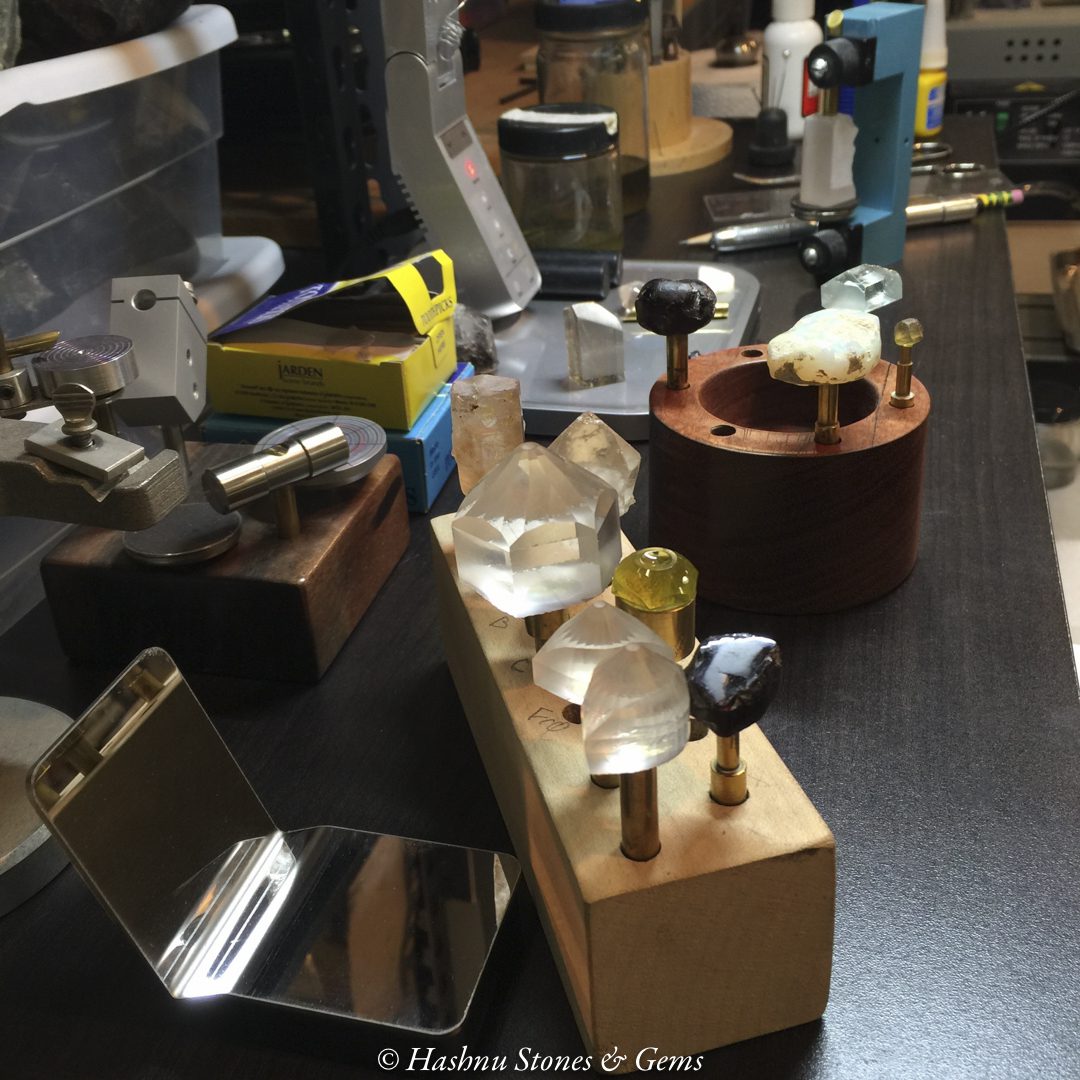Precision Faceting a Story Gemstone: The Faceting Process
The faceting process turns rough stones into finished gems. Learn the steps custom faceters take to create unique gemstones that tell a client's story.
3 Minute Read
Crown Jewel: An Opal Story
Sandra was passionate about opal. She saw some of my faceted opals online and contacted me. She wanted me to facet one of her favorite rough Ethiopian opal nodules. After we spoke, she sent me a link to her website. It featured a picture catalog of her outstanding collection, which included several museum-worthy opal specimens. The faceted opal wouldn't be used in jewelry. Rather, it would be set in a prominent location in her collection cabinet.
Next, we seriously discussed the fragility of all opal rough and the possibility of the stone faulting during the faceting process. I'm very cautious about cutting other people's stones. If a stone has structural problems, I'd rather return it than risk ruining a prized possession. After agreeing to this condition, Sandra sent me the opal. Upon receiving it, I found the opal in very stable condition and agreed to cut it. I was delighted to move on to the next chapter in her opal's story.
Over several video calls, we talked about the nature of opals. None are exactly alike. We discussed the best gem design to showcase the natural beauty of her prized opal. It was opaque. Light return wasn't a consideration. Since the stone wasn't destined for traditional jewelry, we decided to cut crowns on both sides of the opal.
Since I finished the stone in the dead of winter, I waited before sending it to Sandra. Sub-zero temperatures along the mail carrier's path could freeze the opal. When the weather turned warmer, I sent the stone. Now Sandra could return it to her collection.
The Faceting Process: An Overview
After meeting with clients, choosing the rough, selecting a design, and gathering the equipment, we reach a complex chapter in a gem's story. Now, the rough will become a finished stone. Inspired by human desire and artistic expression, the actual gemstone faceting process will reveal the inner beauty of a natural stone.
The custom faceting process goes as follows:
Preforming
The rough stone is ground on a series of wheels or flat laps to get a basic shape called a preform. This allows the faceter to look more closely at the stone and orient it properly for dopping.
Dopping
The faceter attaches the stone to a brass dop (post) that will fit into the spindle of the faceting machine mast. The stone will now become part of the machine and won't move until the pavilion is done.
Pavilion
The pavilion is the term used for the bottom of the stone. At this stage, the faceter completes the pavilion and girdle. The final size of the gemstone is set and ready for the crown.
Transferring
Before cutting the crown, faceters must re-dop the stone so they can finish the other side. This is called transferring the stone.
Crown
The crown, the top part of the gemstone, is cut and polished after transferring. Crown cutting will leave a point/peak of facets that will need to be cut off in the next step.
Table
Faceters now cut and polish the table, the flat top of the gemstone that allows light to enter and exit the gemstone.
Release and Clean
Next, faceters release the finished gemstone from the dop. They can heat the dop (never the stone) or use chemicals to break the glue/wax bond. Faceters now clean the stone and prepare it for shipment.
Freeform and Diagram Faceting
Custom lapidaries take years to learn gem faceting techniques and hone their skills. Of course, I simplified the faceting process for the overview.
Gem design diagrams describe cutting and polishing in a sequence of steps. However, some custom faceters will "freeform" facet based on their experience and imagination. Either kind of faceting is acceptable. The faceting process can take a few hours or dozens of hours, depending on the nature and size of the stone and the complexity of the design.
Precision Faceting A Story Gemstone: 5-Part Series
The Faceting Process (Part 4)
Custom Faceting Advice (Part 5)
Mark Oros
At Hashnu Stones & Gems, we work and play with some of nature's finest creations, gem stones, opals, agates, jaspers, and fossils. We custom facet and carve a great variety of materials for our patrons, collectors, jewelers, artists and our friends. We also provide fellow lapidarists with facet-grade quality rough material for their own creations.
Related Articles
Opal Stones and Gems: Value, Price, and Jewelry Information
Understanding Gem Synthetics, Treatments, And Imitations, Part 4: Synthetic Gemstone Guide
Choosing And Applying Doublet Glue For Jewelry
Eight Opal Types Explained
Latest Articles
Opal Buying Guide
Amethyst Sources Around the World: The Geological Story Behind These Purple Gemstones
Brazilianite Value, Price, and Jewelry Information
Ruby-Glass Composites vs Leaded Glass Clarity Enhancements
Never Stop Learning
When you join the IGS community, you get trusted diamond & gemstone information when you need it.
Get Gemology Insights
Get started with the International Gem Society’s free guide to gemstone identification. Join our weekly newsletter & get a free copy of the Gem ID Checklist!
